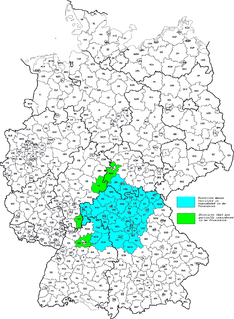
Franconia is a region of Germany, characterised by its culture and Franconian dialect.

Upper Franconia is a Regierungsbezirk of the state of Bavaria, southern Germany. It forms part of the historically significant region of Franconia, the others being Middle Franconia and Lower Franconia, which are all now part of the German Federal State of Bayern (Bavaria).
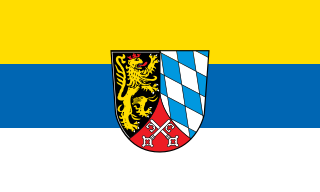
The Upper Palatinate is one of the seven administrative districts of Bavaria, Germany, and is located in the east of Bavaria.
Landsberg am Lech is a Landkreis (district) in Bavaria, Germany. It is bounded by the districts of Aichach-Friedberg, Fürstenfeldbruck, Starnberg, Weilheim-Schongau, Ostallgäu and Augsburg.

Ebersdorf bei Coburg is a municipality in the district of Coburg in Bavaria in Germany.
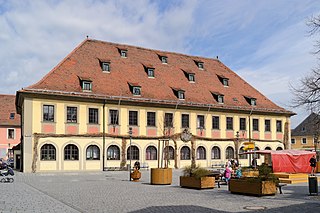
Lichtenfels is a town in the Upper Franconian region of Bavaria, Germany, the administrative seat of Lichtenfels district. It is chiefly known as the German "Basket City".

Forst-Längenbühl is a municipality in the administrative district of Thun in the canton of Bern in Switzerland. It was formed on January 1, 2007 through the uniting of Längenbühl and Forst.

Rattelsdorf is a municipality with market rights in the Upper Franconian district of Bamberg.

Rechtenbach is a community in the Main-Spessart district in the Regierungsbezirk of Lower Franconia (Unterfranken) in Bavaria, Germany and a member of the Verwaltungsgemeinschaft of Lohr am Main. It has a population of around 1,000.

The Mannheim–Stuttgart high-speed railway is a 99 km long railway line in Germany, connecting the cities of Mannheim and Stuttgart. The line was officially opened on 9 May 1991, and InterCityExpress service began on 2 June. The Hanover–Würzburg high-speed railway also opened at the same time. The line cost about DM 4.5 billion to build and has 15 tunnels and more than 90 bridges.
The Nuremberg–Erfurt high-speed railway is a 191 km-long German high-speed railway, between Nuremberg and Erfurt. The line is listed in Germany's federal transport plan as Verkehrsprojekt Deutsche Einheit Nr.8.1 and is a section of the high-speed route between Berlin and Munich and a section of the line connecting Italy and Scandinavia in the European Union's Trans-European Rail network. It consists of an upgraded line between Nuremberg and Ebensfeld and a new line between Ebensfeld and Erfurt. The journey time between Erfurt and Nuremberg will be reduced to approximately one hour and 20 minutes after completion.
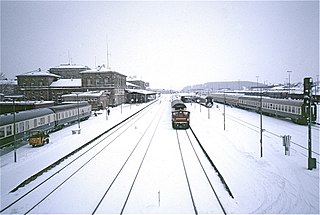
The Bamberg–Hof railway is a 127 kilometre-long main line that runs through Bavaria in southern Germany. The line runs from Bamberg via Lichtenfels, Kulmbach, Neuenmarkt-Wirsberg and Münchberg to Hof. The section from Hof to Neuenmarkt now forms part of the Saxon-Franconian trunk line.
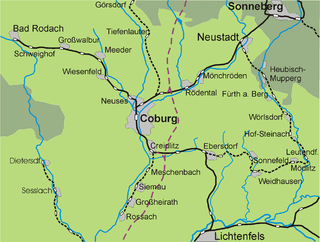
There are six railway stations in the town of Coburg in Bavaria, southern Germany. These include: two passenger stations, three halts and one goods station.

The Eisenach–Lichtenfels railway is a single-tracked main line with a standard gauge of 1,435 mm in Thuringia and Bavaria in southern and central Germany, that runs mostly along the river Werra. It runs from Eisenach via Meiningen to Eisfeld and, formerly, continued to Coburg and Lichtenfels. It was opened in 1858 and is one of the oldest railways in Germany. The railway company that built it, the Werra Eisenbahngesellschaft with its headquarters in Meiningen was also often called the Werrabahn. The company also ran various lines branching off the Werra Railway.

The Nuremberg-Bamberg line is a German railway connecting the Bavarian city of Nuremberg with Bamberg via Fürth, Erlangen, Forchheim. It is part of the northern section of the Ludwig South-North Railway. It runs along the Regnitz Valley and is one of the important German transport routes. Since 2010 line S1 of the Nuremberg S-Bahn uses the entirety of the line from Nuremberg to Bamberg.
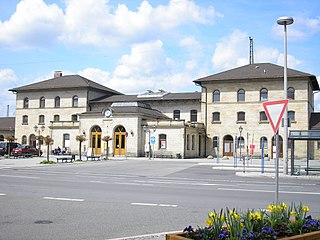
Lichtenfels station is in the town of Lichtenfels in Upper Franconia in the German state of Bavaria. It is a regional rail hub and a former ICE stop on the Hamburg–Berlin Munich route and is classified by Deutsche Bahn as a station of category 3.
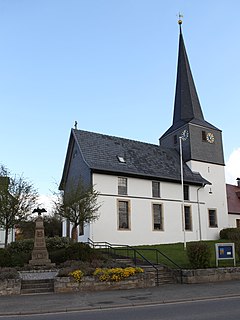
Buch am Forst is a village of 530 inhabitants in the district town (Kreisstadt) of Lichtenfels in the state of Bavaria in Germany. It is 6 kilometers northwest of Lichtenfels and at the western edge of the Lichtenfels Forest. Bundesautobahn 73 [Federal Highway] runs approximately a half-mile (1 km) to the east, while Kreisstraße [District Road] LIF27 goes through the village itself.
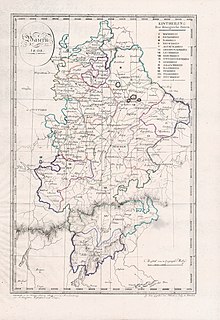
The Mainkreis was one of the 15 administrative districts of the Kingdom of Bavaria between 1806 and 1837. The district was named after its main river Main and renamed Obermainkreis in 1817. It was the predecessor of the Regierungsbezirk Oberfranken.

Hambach Forest is an ancient forest located near Buir in North Rhine-Westphalia, western Germany, between Cologne and Aachen. It was planned to be cleared as part of the Hambach surface mine by owner RWE AG. There were protests and occupations from 2012 against this, and in 2020 a law was passed to preserve it.

Creidlitz is a southern suburb of 1705 inhabitants of the city of Coburg in the county of Upper Franconia in the state of Bavaria in Germany.


















